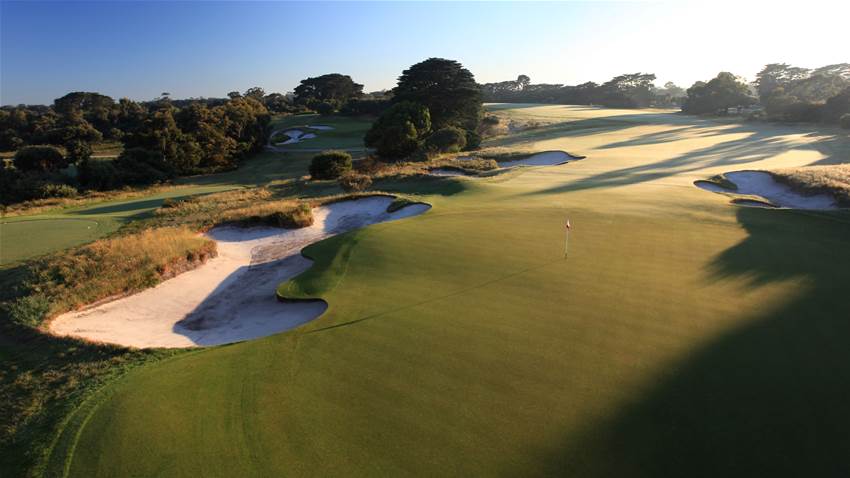The Victorian capital is one of the world’s great golfing destinations. Do you need any more proof other than knowing all 12 courses showcased here have cemented a place in the ranking of the nation’s Top-100 Courses and can be found within a 45-minute drive of Melbourne’s GPO?

5 METROPOLITAN GOLF CLUB
Metropolitan is the second-oldest golf club in the Melbourne Sandbelt having been established in 1908. While the course has changed dramatically during the past 110 years, the layout, in all its incarnations, has never been short of plaudits from here and abroad.
J.B Mackenzie was one of the founding members of the club, most of which came from Royal Melbourne, and he laid out the original course across relatively flat farmland. Thousands of native Australian trees and shrubs were planted beside the fairways in those early years and many of those first plantings remain, adding to the undeniable character of Metropolitan.
Dr Alister MacKenzie made improvements to the bunkering and some of the greens during a visit in 1926 but the biggest alterations came in 1960 when the state government forced the club to sell part of its land for the construction of a school next door. American designer Dick Wilson was then commissioned to create seven new holes and over the years they have easily blended with the original mix of holes.
Further alterations were made to the layout in 2006 with Mike Clayton rebuilding the 12th, 13th and 14th holes as well as making modifications to a further six holes. More recently, Neil Crafter and Paul Mogford (Golf Course Strategies) oversaw work on the par-4 10th hole and had involvement in upgrades to various holes and their surrounds.
Today, the design is revered and is only outdone by the global reputation Metropolitan has for having arguably Australia’s best playing surfaces, which will be on display to the world later this year when the club hosts the World Cup of Golf.
Green fee: Upon application for interstate and overseas guests.

6 WOODLANDS GOLF CLUB
Since 1917, Woodlands has had a reputation as one of the finest courses in the Melbourne Sandbelt.
This reputation is starting to spread as Woodlands emerges from the shadows of its more famous neighbours.
Just before the outbreak of World War I, the then named and newly formed Mordialloc Golf Club commissioned Royal Melbourne’s greenkeeper, Mick Morcom, to consult on the construction of its greens. Three years later, professional golfer, Sam Bennett, laid down the remaining nine holes to complete the course. The original course did not have any bunkering and few trees but all this changed in 1921. The club’s secretary at the time, Hunter Rogers, took an aerial survey of the layout noting all the topographical features and approaches to each green – a first in Australian golf. The bunkers were then constructed and hundreds of native trees, most of which were Flowering Gums and Wattles, were also planted.
By Sandbelt standards, the greens are small. However, they are generally hard and fast as well as being surrounded by sand, hollows and humps. While most of the fairways are generous in width, it is not hard to feel you have to work your ball around the layout to avoid fairway bunkers or an encroaching tongue of rough. This is certainly not a layout where you can just simply bang away with your driver all day.
Green fee: $150 (manager introduced guest from Interstate); $80 (member’s guest).

7 COMMONWEALTH GOLF CLUB
There have been significant upgrades to the Commonwealth layout during the past decade, all of which have lifted the quality of the layout to become one of the nation’s best.
The removal of excess trees and the conversion of all the fairways and greens surrounds to Legend Couch grass are just some of the measures undertaken to improve the course, which is fast approaching its centenary year.
Risk-and-reward is a strong aspect of the Commonwealth design and there is no greater example of it than on the 364-metre 16th hole, one of the most photographed holes on the course. The fairway doglegs left around a lake and some players might be tempted to blast their drives over the water to chase a simple approach and possible birdie. The conservative play can also reap a birdie but the longer approach must be left below the hole on what is a steep sloping putting surface from back to front.
Green fee: $250 (Interstate guests).

8 YARRA YARRA GOLF CLUB
Yarra Yarra Golf Club is arguably one of the least celebrated layouts of Melbourne’s famed Sandbelt region, but not for much longer.
Wisely, the club plans to embrace its glorious rich history to build the foundations of an exciting future. And the major focus of this plan is an extensive renovation of its course to return it to the design concepts of its acclaimed original designer, Alex Russell.
The club has appointed the Tom Doak-led firm, Renaissance Golf Design (RGD), to oversee the extensive changes to the East Bentleigh course, which Russell created in 1928. Russell, the 1924 Australian Open Champion, was the Australian design partner of the legendary Dr Alister MacKenzie and had worked with him at Royal Melbourne during the doctor’s famed 1926 visit.
A significant number of changes have already been made to the layout this year, including the decluttering of many holes on the front nine, the removal of superfluous bunkers and the adjustment of mowing lines to create more playing lines.
This embracing of its past glory is sure to produce something special when the restoration
is complete.
Green fee: Upon application for interstate and overseas guests.
Related Articles

Review: Omaha Beach Golf Club

Drinks With... Ricky Ponting













